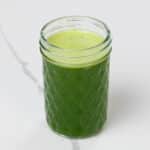Spinach Juice
This wonderful spinach juice blend makes a friendly introduction to green juice. With slightly tropical vibes and just enough sweetness, it's fresh, vibrant, and popular.
Calories: 165kcal
Ingredients
- 1 cup (170 grams) peeled, diced fresh pineapple
- 1 cup packed (30 grams) baby spinach leaves
- 1 small green apple about 6 ounces/(170 grams)
- 1 lime peel and pith removed
Instructions
- Feed the ingredients through juicer in the order listed for maximum yield.
- Divide between two glasses and serve.
Notes
- You can use any spinach that you've got, including more mature leaves and stems, in this recipe. I prefer to use baby spinach for its milder, sweeter flavor and less-prominent tannins.
- Use nice, ripe pineapple for best flavor and yield. You'll peel it, but feel free to juice the core as well as the softer flesh.
- Lime adds an element of tanginess and freshness. You'll use a knife to cut off the peel and white pith and then put the rest of it through the juicer.
- A tart green apple (such as Granny Smith) is one of my favorite green juice ingredients. It adds a bit of complex sweetness and tartness that complements virtually all juices, while keeping things relatively low-glycemic. You don't need to peel it. The rest of the prep depends on your juicer — see manufacturer's instructions for best results.
- I use the Kuvings Whole Slow Juicer, a masticating juicer that juices pretty efficiently and preserves nutrients for a longer period than centrifugal juicers. You can make this recipe with any juicer.
- The nutrient retention in fresh juice has a lot to do with what kind of juicer you're using. If you have a centrifugal juicer, it's best to drink your juice fairly soon after you make it. With a masticating juicer, feel free to juice in larger batches. They'll keep well in an airtight container in the fridge (such as a quart-sized mason jar) for two to three days.
- Juice can be frozen for longer storage, but you'll find that any remaining solid bits fall out of suspension and sink to the bottom after defrosting. I'm not personally a huge fan of the texture of defrosted juice, but if you're okay with it, freezing can be a good bet.
Nutrition
Calories: 165kcal
